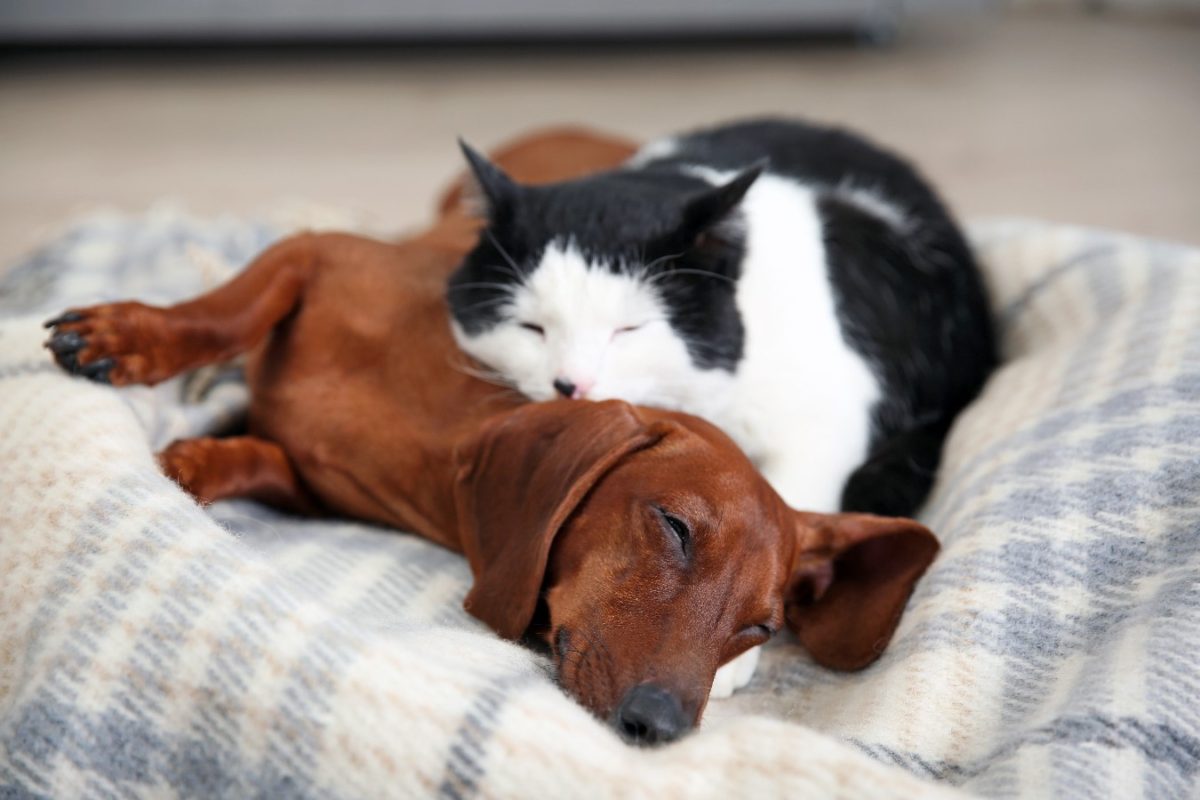Behavior, Everything, Cats, Dogs, Pets
Can Cats and Dogs Live Together?
Fluffy and Fido play together, eat together, and even sleep together – or so you’ve heard. Some cats and dogs do become best friends, while in other households, they just tolerate each other, or they don’t get along at all.
Millions of Americans live with at least one dog and one cat. How do they do it?
Choosing cat and dog housemates
Unfortunately, not all cats and dogs can get along with each other. Some dog breeds, particularly hunting dogs and terriers, have an instinctual drive to chase and attack. Some older cats and dogs as well as some younger ones may not be able to adapt to living with another animal.
On the other hand, some cats and dogs adjust better to sharing their home with a different species than with their own species; they’re less likely to feel territorial.
If you already have a cat and you’re adopting a dog from a shelter or rescue organization, find out as much as you can about the dog’s background. Is the dog a hunting breed or a terrier? Has the dog lived with cats before? Ask if you can see the dog with cats before completing the adoption.
If you’re adopting a cat into a household with a dog, ask about her history at the pre-adoption stage. She may have a known aversion to dogs, or she may have lived happily with dogs before.
The addition of a cat to a household with two dogs might not be safe for the cat. The dogs may be fine with a cat on their own, but together, their pack instinct can take over.
Before Fluffy and Fido meet
Once you’ve chosen the new addition to your family, you should be the one to bring the new cat or dog into the home. Let the other animal see that the new arrival is your decision.
Don’t put the animals together right away. Keep them in separate areas of your home for the first few days, where they can get used to the scent and sounds of the other animal. When you go from one animal’s area to the other, let the animals sniff your hands and clothing. You can bring them a blanket that the other animal slept on to reinforce the other animal’s scent.
When the new pet is accustomed to the new surroundings, have the animals change areas for long enough to give the new cat or dog time to explore the territory.
During this pre-introduction stage, you’ll want to spend time with the new pet. Be sure to give the other pet extra attention to prevent feelings of jealousy. This is a good time to reinforce basic training with dogs to avoid problems during the introduction.
Dog and cat introductions
After a few days apart, it’s time for Fido and Fluffy to see each other. You may want to open the door between the animals’ areas while keeping the dog on a leash. Another introduction method is to bring the dog and cat into the same room with two people, one to handle each animal. Keep the dog and cat at a distance, and gradually (over a few days if necessary for their comfort level) let them get closer to each other.
Repeat the get-to-know-you sessions daily. Even when your dog appears friendly, keep him on a leash when the animals are together. If you give him plenty of exercise beforehand, he’ll be less inclined to want to chase the cat for entertainment.
When the dog and cat are ready to be together unrestrained, leave the leash on the dog so that you can hold the dog back if necessary. Never leave the dog and cat together unsupervised until you’re sure that they get along fine. Allow several weeks for this stage.
If your cat is allowed outdoors, keep her indoors until she’s accustomed to the dog. When you do let her outside, observe how the dog and cat behave together outside as well as inside. Dogs with a hunting instinct may tolerate cats inside the house but be compelled to chase them when they’re outside, especially if the cat is moving.
Household arrangements
Provide your cat with a cat-only area for the litter box, scratching post, and cat toys. Block the area from the dog with a baby gate or a cat door. If possible, provide places to climb in the common rooms so that the cat can get away from the dog if she wants to. Your dog may appreciate a dog-only area too.
Feed the dog and cat in separate areas until you’re sure that they get along. For some animals, this arrangement should be permanent.
When they’re puppies and kittens
The best time to socialize dogs and cats together is when they’re puppies and kittens. If your household has puppies or kittens but not the other species, consider introducing them to tolerant cats or dogs while they’re young. Doing this will make future transitions easier.


